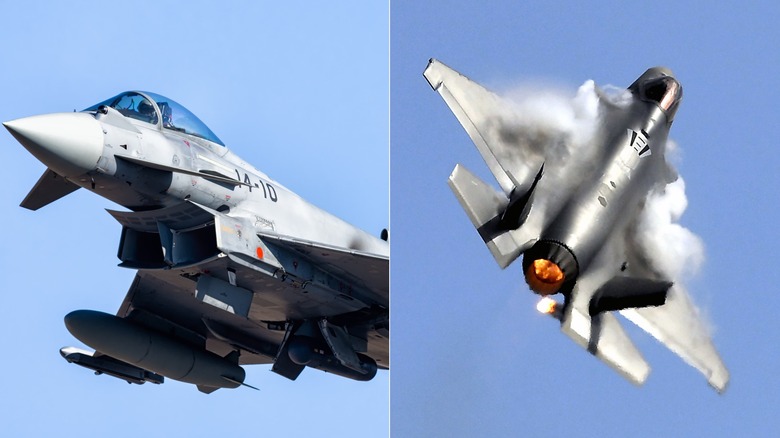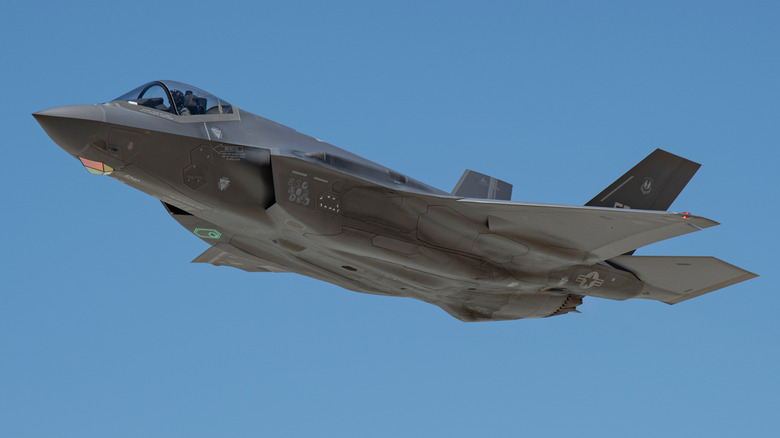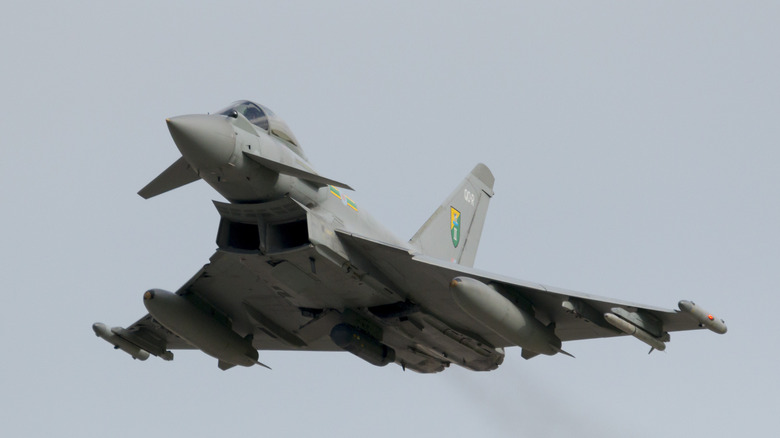F-35 Lightning II Vs Typhoon FGR4: How Do The Fighter Jets Compare?
There are some exceptionally advanced fighter jets in the armed forces of the world. When one thinks about a next-generation fighter, they typically think about the F-22 Raptor or more likely the F-35 Lightning II. This is a fighter jet that's used by multiple air forces, including Britain's Royal Air Force. However, the RAF already had their own advanced warfighter that's been in production since 1994. Okay, '94 is three decades old, but the Typhoon FGR4 continues to be the backbone of the RAF (amongst other nations) and does a decent job with keeping up with Lockheed Martin's Joint Strike Fighter (JSF).
The F-35 Lightning II JSF and Typhoon FGR4 are both multirole fighters capable of switching between air-to-air and air-to-surface missions when needed. However, that's the extent of their similarities. Besides the drastically different appearance–the Typhoon has a canard delta-wing design while the F-35 has a blended wing-body appearance– they're both from completely different generations of fighter jets. The F-35 is more modern and categorized as a fifth generation fighter, while the Typhoon falls into the fourth generation category, similar to the F-16 Falcon.
The RAF is expected to replace the Typhoon in the 2030s at some point — there are currently three generations of the Typhoon in service– and will have run the limit of its service life by then. The F-35, on the other hand, won't be replaced but will be complemented by a sixth generation fighter. But let's take a look at these two fighter jets and see how they compare.
The F-35
Next to the F-22 Raptor, the F-35 Lightning II JSF is the U.S. military's pride and joy as far as fighter jets go. It's a fifth generation multirole fighter capable of supersonic speeds with variants for the Air Force, Navy, and Marine Corps. Not to mention, it has a small cross-section that makes it difficult to detect on radar. The Marine Corps' F-35B variant is capable of short takeoff and vertical landing (STOVL), similar to its old AV-8B Harrier II. Lockheed Martin started manufacturing the F-35 in 2003. Three years later, the first one took flight and by 2011, both the Air Force and Marine Corps received their first F-35 variants.
F-35 pilots wear a specialized helmet that connects to the plane's avionics, giving them all the data and targeting information they need while on mission. The fighter's Electro-Optical Distributed Aperture System (DAS) improves the pilot's situational awareness with an enhanced missile warning and aircraft warning system. It all feels like something out of science fiction that's ahead of its time, essentially making the jet an extension of the pilot.
Its single Pratt & Whitney F135-PW-100 turbofan engine produces 43,000 pounds of thrust, pushing the jet to a maximum speed of Mach 1.6. It can fly as high as 50,000 feet, maybe a little more, and can travel a total of 1,350 miles. However, thanks to the wonders of midair refueling, it technically has no limits. America is continuously adding more allied nations to the F-35 program, with 15 other countries gaining use of it and more than 400 JSFs expected to be stationed at NATO bases by 2030.
The Typhoon FGR4
The Typhoon FGR4 is the Royal Air Force's backbone and surprisingly costs more than the controversial F-35A. It's a twin-engine delta-wing fighter jet capable of switching between roles in a single deployment. Where Lockheed Martin manufactured the bulk of the F-35, the Typhoon was a joint effort between BAE Systems, Airbus, and Leonardo. Its twin EJ200 engines were built by Rolls-Royce and make it a hair faster than Lockheed's JSF. It can fly Mach 1.25 at sea level, but at altitude it hits Mach 2. With the afterburner engaged, the engines can produce a max of a little more than 40,000 pounds of thrust–20,000 from each engine. It can be off the ground and in the air from a standstill in less than eight seconds.
Roughly only 15% of the Typhoon's airframe is metal, the rest being made of composite materials, giving it a significantly low radar signature. However, it's not a stealth fighter in the same way the F-35 is a stealth fighter. It has an internal 27mm Mauser cannon, but when it needs the big guns, it can be equipped with Advanced Short Range Air-to-Air Missiles (ASRAAM), Advanced Medium-Range Air-to-Air Missiles (AMRAAM), precision-guided bombs, as well as air-to-ground missiles. If it's in need of reaching a target out of its range, it can also be equipped with up to four drop tanks.
The National Interest notes that "The international clientele is attracted to how agile the Typhoon flies." Pilots had a hand in designing the Typhoon, creating an intentional unstable airframe that makes the Typhoon an especially agile fighter jet at subsonic speeds.


